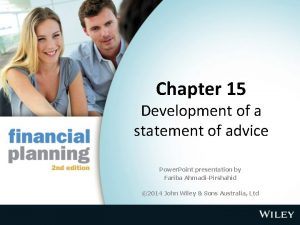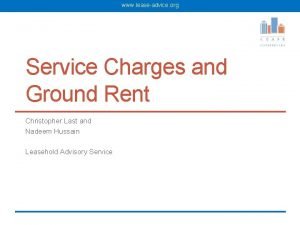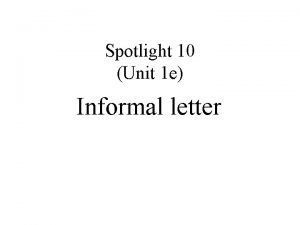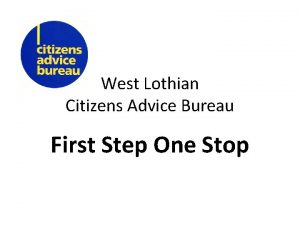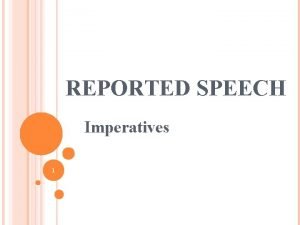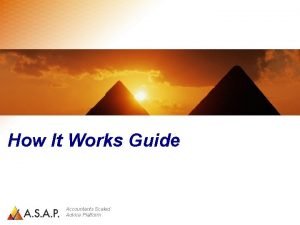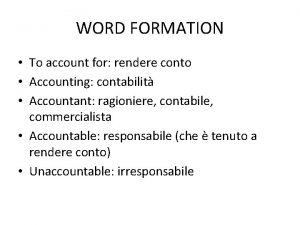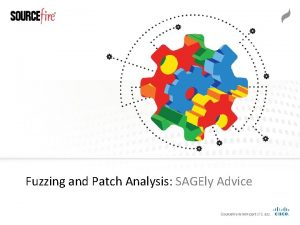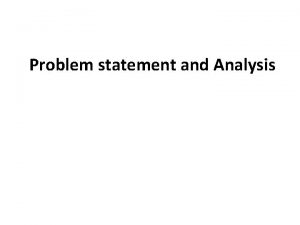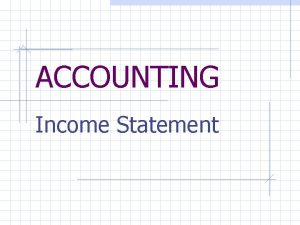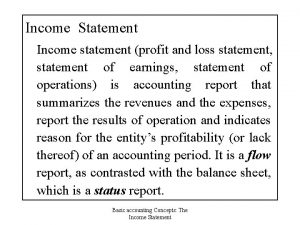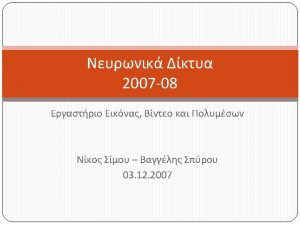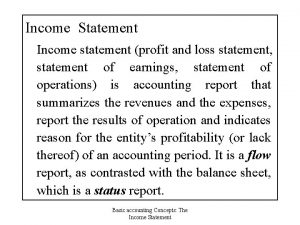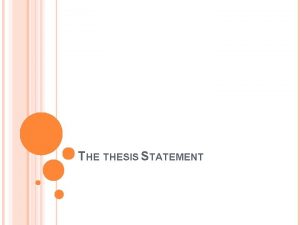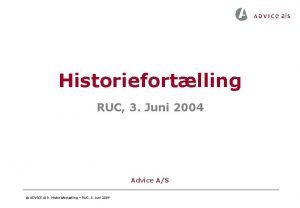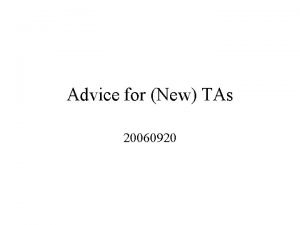Chapter 15 Development of a statement of advice











































- Slides: 43

Chapter 15 Development of a statement of advice Power. Point presentation by Fariba Ahmadi-Pirshahid © 2014 John Wiley & Sons Australia, Ltd

Learning objectives After studying this chapter you should be able to: 1. 2. 3. 4. 5. 6. 7. 8. 9. understand the disclosure requirements for the provision of a financial product outline the key principles behind the provision of financial advice explain when a statement of advice is required and its purpose explain the circumstances under which a statement of advice is not required outline the main types of statement of advice documents used in the marketplace appreciate the importance of effective communication in a statement of advice understand the importance of the planner–client relationship explain the six-step financial planning process used to prepare a statement of advice understand the various ethical and legal compliance issues involved in developing a financial plan 10. appreciate the important components of a statement of advice.

Introduction • To successfully manage finances, a person needs to have a personal financial plan • The plan should include client’s goals and objectives, put forward strategies and recommendations and describe how goals will be achieved • Comprehensive analysis of all disciplines needs to be considered in a typical financial plan formally referred to as Statement Of Advice (SOA) • SOA is the means of communicating the advice to the client

Disclosure requirements • Financial planners are required to provide clients with certain information prior to giving advice. • The main disclosure documents are: – Financial Services Guide (FSG) – Statement of advice (SOA) – Product disclosure statement (PDS).

Legal obligations relating to the provision of financial advice • New obligations within Part 7. 7 of the Corporations Act

Best interest obligations • The best interest obligations means that a planner has three separate duties: 1. a duty to act in the client’s best interest 2. a duty to provide advice that is appropriate 3. a duty to prioritise the client’s interests in the event of a conflict.

Statement of advice (SOA) • The purpose of an SOA is to communicate advice and recommendations concerning the financial affairs of a client • The statement of advice (SOA) must contain sufficient information to enable people to make an informed decision about whether: – the advice is appropriate – they should act on it. • An SOA is required under s. 946 A of the Corporations Act

Statement of advice continued • Suitability rule — having a reasonable basis for the advice. The planner must be able to show: • reasonable enquiries were made re the clients personal circumstances • the subject matter of the advice was considered and investigated • the advice was appropriate for the client. • A statement of advice (SOA) must be given to the client at the same time as, or as soon as practicable after, the advice is provided (s. 946 A) (see also RG 175. 149).

Statement of advice continued • These elements require the planner to undertake an appropriate and reasonable level of investigation to ensure that the advice provided is fit and appropriate to meet the needs and requirements of the client. Investigations must be made into both: • the client’s situation (know your client) • into suitable financial products (know your product). • Information presented must be tailored to the clients level of financial literacy.

Statement of advice continued • SOA is generally required when personal advice is given to retail clients. • SOA is not required when: – the client is not a retail client – personal advice is provided to clients having a small amount of funds to invest (S 946 AA) (< $15 000) – the advice does not involve the purchase of a financial product and where the entity providing the advice does not receive any remuneration – providing further advice to a client.

Obligations when providing further advice • When a client is provided with further advice, SOA is not required if: – an SOA is already provided which includes client’s circumstances – the client’s circumstances have not changed significantly – the basis of advice is not significantly different from the advice in the previous SOA. • In such cases, the financial adviser can provide an alternative advice document to the client known as a Record Of Advice (ROA).

Types of SOAs There are three types of financial plans (written advice) that financial planners are expected to provide. No advice Limited Advice A document signed by a Known as scaled client stating that no advice, sought by advice was given by a clients in various planner in respect of a specific circumstances transaction — for example to execute a transaction Comprehensive SOA Incorporates all six steps of financial planning process

Types of SOAs continued • Pursuant to s. 945 B clients must be provided with a warning if advice is based on incomplete information • Care should be taken to ensure that all strategies and discussions contained in the body of the SOA are specific to the client’s circumstances • Should be prepared with the client’s level of financial sophistication in mind

Effective communication in SOA • SOA should provide detailed strategies and projected outcomes • It should be written in plain English understandable by the client • ASIC’s Good Disclosure Principles promote disclosure to: – be timely, relevant and complete that provides product understanding and allows product comparison – highlights important information – have regard to consumers’ needs.

Introductory meeting — purpose: • to establish the relationship between the planner and the client • to provide the planner with an opportunity to learn about the client, their circumstances and needs and to determine what the client is hoping to accomplish from the relationship • to provide the client with an opportunity to learn about the planner and the services they offer and whether the planner is likely to be able to satisfy the client’s requirements.

The six steps of the financial planning process

Step 1: Gather client information • Fact finders are used to create a basis for the financial plan • The financial planner needs to look beyond the quantitative information provided by the client, and ensure that qualitative issues are also considered • The planner normally also assesses the client’s risk profile to determine risk profile and risk capacity — an integral part of the ‘know your client’ process

Step 2: Establish financial goals and objectives • Examples of asset allocations for different risk and return profiles

Step 2: Establish financial goals and objectives continued • The planner’s role is to help the clients develop and clarify their objectives in the short, medium and long term • Client objectives need to be clear, specific and measurable • Planner discusses with client the extent to which the goals are achievable, realistic or optimistic

Step 2: Establish financial goals and objectives continued • Identify problems / conflicts between goals and strategies / recommendations: – analysing opportunity costs – agreement on trade-offs – decisions about priorities – confronting ethical issues.

Step 3: Analyse data and identify financial issues • Issues include: ascertaining cash inflows and outflows to determine saving capacity assessing income tax obligations assessing the appropriateness of the asset allocation determining the extent to which the current wealth creation of a client is likely to generate sufficient funds for retirement – assessing social security entitlements – determining whether personal insurance cover is adequate and appropriate – comparing proposed strategies and investment products versus the client’s risk tolerance and objectives. – –

Step 3: Analyse data and identify financial issues continued • Preparation of personal financial statements: – Balance sheet – Income statement – Cash flow statement • Use of ratio analysis to assess client position via personal financial statements • The planner may also undertake financial modelling to determine whether the strategies being recommended will achieve their desired purpose…

Step 4: Prepare written recommendations • The planner communicates appropriate recommendations and strategies in a way that allows clients to make informed decisions • This is done through a comprehensive and detailed SOA

Step 4: Prepare written recommendations continued • Reasonable assumptions included in SOA: – Tax rates – Inflation – Interest rates – Income and capital investment returns – Life expectancy of clients

Step 5: Implement the agreed-upon plan • Planner and client agree on – how recommendations and strategies are to be implemented – who should perform them. • A timetable should be established for each stage of implementation together with breakdown of responsibilities. For example: Action When Who Client to salary sacrifice Immediately The client to organise through their employer $1500 per month into their superannuation fund

Step 5: Implement the agreed-upon plan continued • This will normally be followed by documents for client to sign • Comprehensive record keeping crucial at this stage for both planner and client

Step 6: Review, revise and maintain the personal SOA • Periodic review (typically 6 -monthly) required to ensure ongoing appropriateness of recommendations and strategies developed under SOA • Review should follow Steps 1– 5 • Written agreement is recommended to set out role and responsibilities of the financial planner

Ethical and legal compliance issues • Financial planners have a professional and fiduciary obligation to look after the interests of the client without bias or conflict and in a manner that establishes a relationship of trust, confidence and discretion

Ethical and legal compliance issues continued • Two tests to gain a reasonable basis for recommendations – Know your client – Know your product • A financial adviser who is found not to have complied with these two tests may be liable to compensate clients who suffer financial losses from relying on adviser recommendations

Ethical and legal compliance issues continued • Know your client – Client records must be stored safely and kept confidentially – Access to client files may be required by the courts or ASIC – Ownership of client records and files always lies with the licensee and not the adviser

Ethical and legal compliance issues continued • Obligation to provide a full, transparent and frank disclosure of all remuneration within the SOA • Remunerations models varies and may based on commissions, fee-for-service, or an hourly rate • Example of the disclosure of remuneration:

Important components of SOA • • Prepare a complying covering letter Prepare a contents page Prepare an executive summary Scope of the advice Refer to the client’s present position Goals and objectives Strategies Fees and charges including the cost of advice

Important components of SOA continued • The recommendations set out for the client should enable the client to determine: – – – what the advice is why the advice is appropriate the benefits of the advice the risks and disadvantages associated with the advice the consequences of replacing financial products. • To facilitate understanding and comprehension, advice may be displayed through the use of graphs, tables and charts.

Important components of SOA continued • Develop appropriate strategies – – – – – Cash flow projections Income tax planning Risk management and insurance Social security matters Investment planning Superannuation and retirement planning Estate planning Cost of the advice and how the planner is paid Specific disclaimers How to proceed

Planning for implementation • Plan needs to be agreed upon, signed and consented to prior to implementation • It is reasonable to expect that clients will take time to decide on implementation of the plan • It is unrealistic to expect prospective clients to give immediate agreement • Clients’ outstanding queries should be resolved any necessary amendments made to plan • Service agreement defining rights and responsibilities of client and planner should be prepared and signed

Periodic review and maintenance • Financial planner should describe: – the process of review, maintenance and monitoring of the plan – the frequency proposed – the charges for providing these services to clients. • A review is an evaluation of whether the existing plan continues to meet the clients’ needs or requires adjustment.

Periodic review and maintenance continued Steps in the Review Process • Review clients’ goals, objectives and needs • Assess investment and financial strategies • Modify portfolio for better performance • Assess health of investments against benchmarks • Implement the investment decisions • Discuss client’s current risk profile • Discuss effect of legislative changes • Assess existing investment portfolio • Record everything in writing

Periodic review and maintenance continued • Disclaimers are useful tool in the preparation of personal SOAs but have limitations • Cannot disclaim fiduciary obligations to: – act in the best interest of the client – exercise a duty of care.

Periodic review and maintenance continued • Examples of commonly used disclaimers include: – no responsibility to parties other than the SOA recipient – taxation issues referred to client tax accountant – sunset clause for recommendations – recognition of client provided information as basis for recommendations.

Summary The practise of financial planning encompasses many disciplines: – – – investments retirement planning superannuation insurance taxation planning – – portfolio management social security debt management financial analysis.

Summary continued • Effective communication — an open, honest, trusting relationship is vital • 6 step financial planning process provides framework for development of the SOA • Planners have a professional, fiduciary obligation to look after the interests of the client

Summary continued • Skills considered essential for the professional financial planner: – critical thinking – analysis – interpretation – problem solving.

 What is a statement of advice
What is a statement of advice Www.lease-advice.org
Www.lease-advice.org How to format an open letter
How to format an open letter Type of user support
Type of user support Difference between advice guidance and counselling
Difference between advice guidance and counselling Musicians union legal advice
Musicians union legal advice Rejecting help
Rejecting help Catcher in the rye pages
Catcher in the rye pages Writing a letter giving advice
Writing a letter giving advice Provide housekeeping services to guests
Provide housekeeping services to guests Child countable or uncountable
Child countable or uncountable Advice column sample
Advice column sample Asking for and giving advice
Asking for and giving advice Lucy gratton
Lucy gratton Example informal letter giving advice
Example informal letter giving advice Informal letter giving advice
Informal letter giving advice Advice ielts speaking part 3
Advice ielts speaking part 3 Laertes advice to ophelia
Laertes advice to ophelia Reported speech verbs
Reported speech verbs Giving advice dialogue
Giving advice dialogue Do boys and girls share the same internet usage?
Do boys and girls share the same internet usage? Biom advice
Biom advice We have to obey our teachers
We have to obey our teachers Asking for and giving advice
Asking for and giving advice Advice for applying machine learning
Advice for applying machine learning What advice did nick's father give him
What advice did nick's father give him Very brief advice
Very brief advice Suggestion modals
Suggestion modals Citizen advice livingston
Citizen advice livingston Reported speech imperatives
Reported speech imperatives Ask and give advice
Ask and give advice What is scaled advice
What is scaled advice Essay basics
Essay basics Citizens advice bureau eastbourne
Citizens advice bureau eastbourne Divisibility rules of 2 3 4 5 6 9 and 10
Divisibility rules of 2 3 4 5 6 9 and 10 Wont bouncer therapist referee have advice
Wont bouncer therapist referee have advice Who bore the gods prisoning anger for his pride
Who bore the gods prisoning anger for his pride Profit word formation
Profit word formation Verb pattern expect
Verb pattern expect Advice pg
Advice pg Shipping advice
Shipping advice Galvanic body treatment
Galvanic body treatment Sagely advice
Sagely advice Future of financial advice reforms
Future of financial advice reforms
